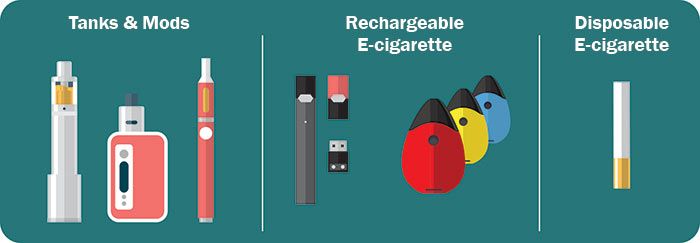E-cigarettes / Vaping
Know the Risks and Get The Facts.
E-cigarette use among both youth and young adults has increased considerably in recent years. According to the 2017 NH Youth Risk Behavior Survey, e-cigarette among youth is double that of combustible cigarettes and more than a third of 12th grade males report currently using e-cigarettes.
E-Cigarettes and Young People: A Public Health Concern
Talk with teens and young adults you know about the dangers of e-cigarette use.
E-cigarettes, devices that typically deliver nicotine, flavorings, and other additives to users through an inhaled aerosol, are a rapidly emerging trend, and are especially popular among youth and young adults. These devices are referred to by a variety of names, including “e-cigs,” “e-hookahs,” “mods,” “vape pens,” “vapes,” and “tank systems.” E-cigarettes can also be used to deliver other drugs besides nicotine, such as marijuana.
Scientists are still learning more about how e-cigarettes affect health. However, there is already enough evidence to justify efforts to prevent e-cigarette use by young people. We know that the vapor from e-cigarettes is harmful because it contains harmful ingredients, including nicotine. Nicotine exposure during adolescence can cause addiction and can harm the developing brain.
In 2016, a U.S. Surgeon General’s Report on e-cigarette use among youth and young adults became the first report issued by a federal agency that carefully reviewed the public health issue of e-cigarettes and their impact on our nation’s young people. Because most tobacco use starts during adolescence, actions to protect our nation’s young people from a lifetime of nicotine addiction are critical.
What is an E-Cigarette?
- E-cigarettes are tobacco products. The U.S. Food and Drug Administration (FDA) deemed e-cigarettes, cigars, and hookah and pipe tobacco, as tobacco products in 2016.
- E-cigarettes are “vaping” devices that mimic the act of smoking.
- Battery-powered devices that heat a liquid mixture that usually contains nicotine and other ingredients, which are inhaled by the user.
- They come in many shapes and sizes.
- There are now approximately 8,000 e-juice flavors (like menthol, fruit, candy, chocolate, sweets). The variety of flavors attracts youth to trying them.
Are E-Cigarettes Safe?
- The U.S. Food & Drug Administration has the authority to create manufacturing and labeling standards. Currently there are no standards or regulations, resulting in various levels of nicotine and other chemicals in the liquid placed inside of them.
- The aerosol that comes from e-cigarettes contains harmful and potentially harmful ingredients, including nicotine, ultrafine particles, heated flavorings, volatile organic compounds, and heavy metals.
- E-cigarettes are illegal for kids under 18 years of age.
- The brain continues to develop through the early to mid-twenties. Nicotine use during this time can:
- Disrupt the formation of brain circuits that control attention and learning.
- Activate the limbic system more strongly, which can lead to addiction.
- Nicotine can be poisonous, especially in liquid form often called e-juice, e-liquid, or liquid nicotine. E-juice is harmful to children. Just a few drops absorbed by the skin or swallowed can send a child to the emergency room. Ingesting as little as half of a teaspoon of e-juice, may be fatal for children. It is important to store all nicotine products out of reach of children.
- E-cigarettes as cessation aids (help with quitting tobacco)
There is very limited scientific information available about the use of e-cigarettes as a cessation aid. Please note that without manufacturing and regulatory standards, conducting randomized clinical trials remains challenging.
- E-cigarettes as cessation aids (help with quitting tobacco)
Can E-Cigarettes Help You Quit Tobacco?
Studies on e-cigarettes as a quitting aid for nicotine addiction and cigarette use are few, with mixed and modest results. Some show that they are about equal in effectiveness to that of nicotine replacement therapy (NRT) – like the nicotine patch. The best way to quit is to use quit line counseling and FDA-approved medications.
- The health effects of e-cigarette use are not known, but e-cigarettes are likely safer than combustible tobacco products.
- The ultimate goal must be to quit traditional (burning tobacco) cigarette use in order to protect your health.
- Dual use (using both products) is not a good long-term goal.
Resources
Program/Curriculum
New Hampshire
- BreatheNH
- NH Tobacco Prevention and Cessation Program – E-Cigarette Public Health Advisories
- Northern New England Poison Center: E-Cigarettes School Nurses Webinar
National
- BeTobaccoFree.gov: About Electronic Cigarettes
- Campaign for Tobacco Free Kids
- Centers for Disease Control, Office of Smoking and Health
- Juulers Against Juul
- Surgeon General – Know the Risk of E-Cigarettes and Young People
- Truth Initiative
- US Food and Drug Administration: E-Cigarette Regulation






